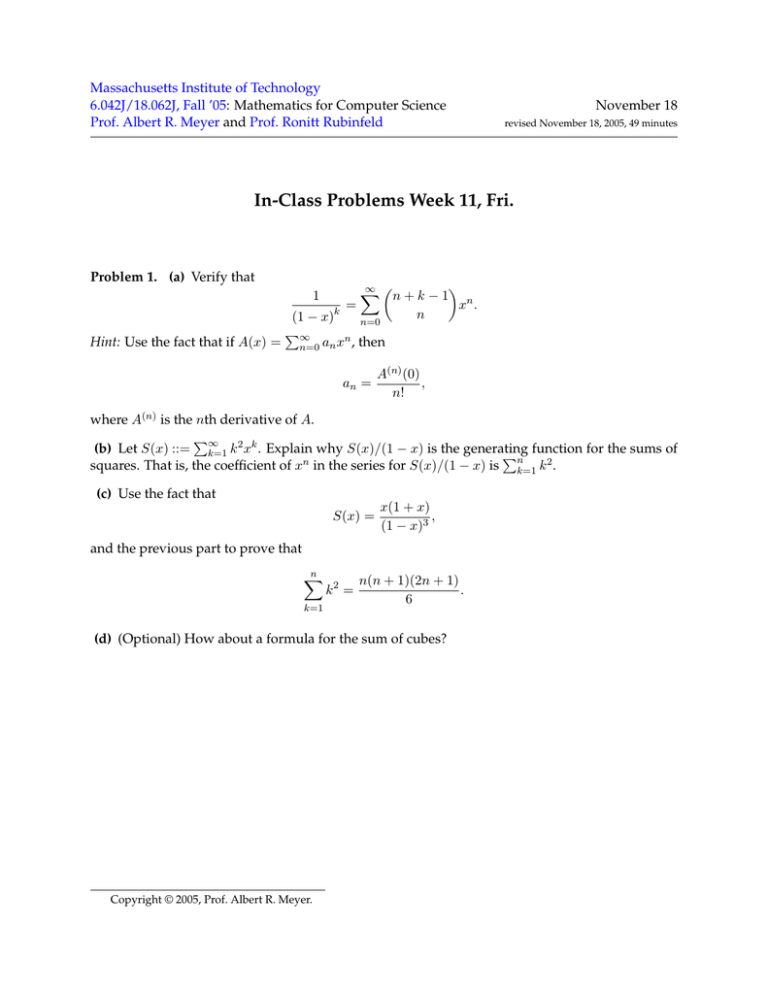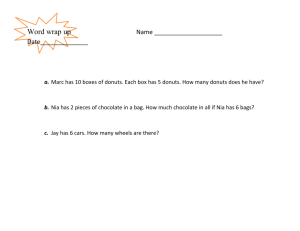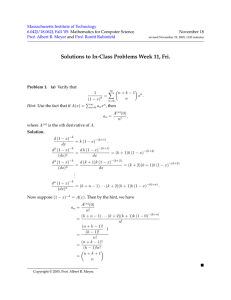: Mathematics for Computer Science November 18 and Massachusetts Institute of Technology
advertisement

Massachusetts Institute of Technology 6.042J/18.062J, Fall ’05: Mathematics for Computer Science Prof. Albert R. Meyer and Prof. Ronitt Rubinfeld November 18 revised November 18, 2005, 49 minutes In­Class Problems Week 11, Fri. Problem 1. (a) Verify that � ∞ � � n+k−1 1 = (1 − x)k n=0 �∞ Hint: Use the fact that if A(x) = n=0 an xn , then an = n xn . A(n) (0) , n! where A(n) is the nth derivative of A. � 2 k (b) Let S(x) ::= ∞ k=1 k x . Explain why S(x)/(1 − x) is the generating � function for the sums of squares. That is, the coefficient of xn in the series for S(x)/(1 − x) is nk=1 k 2 . (c) Use the fact that S(x) = x(1 + x) , (1 − x)3 and the previous part to prove that n � k=1 k2 = n(n + 1)(2n + 1) . 6 (d) (Optional) How about a formula for the sum of cubes? Copyright © 2005, Prof. Albert R. Meyer. 2 In­Class Problems Week 11, Fri. Problem 2. We are interested in generating functions for the number of different ways to compose a bag of n donuts subject to various restrictions. For each of the restrictions in (a)­(e) below, find a closed form for the corresponding generating function. (a) All the donuts are chocolate and there are at least 3. (b) All the donuts are glazed and there are at most 2. (c) All the donuts are coconut and there are exactly 2 or there are none. (d) All the donuts are plain and their number is a multiple of 4. (e) The donuts must be chocolate, glazed, coconut, or plain and: • there must be at least 3 chocolate donuts, and • there must be at most 2 glazed, and • there must be exactly 0 or 2 coconut, and • there must be a multiple of 4 plain. (f) Find a closed form for the number of ways to select n donuts subject to the constraints of the previous part. Appendix Products of Series Let A(x) = ∞ � n=0 an xn , B(x) = ∞ � bn xn , C(x) = A(x) · B(x) = n=0 Then cn = a0 bn + a1 bn−1 + a2 bn−2 + · · · + an b0 . ∞ � n=0 cn xn .








